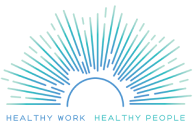Free Report
If you choose, after completing the survey, you can receive a free email report showing your results compared to a U.S. national population, so you can see if your work stress is greater, less than or similar to others. The report will also offer strategies and solutions based on the specific stressors you face at work.
The stress we experience from work is not just in our heads; it is caused by policies, practices and demands in the workplace. Chronic (long-term) exposure to workplace stressors can lead to mental ill health, such as burnout and depression, as well as cardiovascular problems, such as high blood pressure, heart disease or stroke. For more about unhealthy work as well as information about healthy work, see www.healthywork.org.
What Do My Results Mean?

The results from the Healthy Work Survey show your “risk” for some of the most common, health-damaging work stressors. Your score is categorized as “low”, “intermediate” or “high” by comparing your results to data from the nationally-representative Quality of Worklife survey of the U.S. working population.
- High Risk means your score falls in the group with the highest reported level of a given work stressor in the U.S. national working population.
- Intermediate Risk means your score is in the “middle level” group for a given work stressor in the national working population.
- Low Risk means your score falls in the “lowest level” for a given work stressor in the national working population.
The following sections give you information about the significance of the workplace stressors measured in the Healthy Work Survey, and what you could do to improve your scores in each category.
High Job Demands
High workload
Inadequate resources
Long work hours (in the past week)
Low Job Control
Low ability to make decisions
Low use of skills
Work-Family Conflict
If you have scored in the highest risk level in the U.S. population for work-family conflict, this means you have high levels of work-family (or work-life) conflict compared to most U.S. workers. Work-family conflict is a lack of time and energy to adequately meet both the demands of work and non-work life simultaneously. You come home too tired after work to do the things you enjoy or you have so much work that it prevents you from spending time with family or friends or pursuing personal interests. Also, challenges at home might interfere with your ability to perform your job. Work-family conflict is a major stressor that can lead to burnout, sleep problems and other health and productivity outcomes. There are some ways to reduce work-family conflict if an organization is willing to train supervisors and other managers to practice more family-supportive supervisor practices, and to provide flexible work policies (e.g. working from home, part-time hours, shared jobs). Here are some ideas from others who have reduced work-family conflict on the job.
Low Rewards
If you have scored in the highest risk level in the U.S. population for low rewards, this means you are less likely than other workers in the U.S. to experience respectful work, fair promotion opportunities, and job security. Also, you may be more likely to report that what you earn on the job is less than what you deserve or less than others who do the same job. When rewards do not match the required effort or responsibility of a job, this is also a major stressor called effort-reward imbalance which can increase your risk for depression, burnout and CVD. Here are some ideas from others who have improved “rewards” on the job.
Lack of promotion opportunities
Poor Safety Climate
If you have scored in the highest risk level in the U.S. population for poor safety climate at work, this means you report that management at your workplace is less likely to prioritize the safety of workers or that they take shortcuts when it comes to worker health and safety. A healthy work environment should be free of physical hazards, including safety and mechanical hazards, toxic chemicals, noise, radiation, infectious diseases, extremes of heat and cold, and ergonomic design hazards. Poor safety climate may mean you are at risk of work-related injury and illnesses. You have a right to know what hazards you are exposed to in your workplace and there are many organizations in your county or state that can help you identify and report hazards.
Is your work healthy?
For more information about (un)healthy work, go here.
For Healthy Work Tools for Individuals, go here.
For Healthy Work Strategies – case studies showing how others have improved work stressors, go here.
If you want to stay informed about the Healthy Work Survey and receive other updates, please sign up for our Newsletter.






